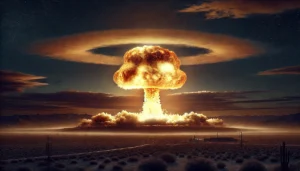 On July 16, 1945, the world entered the atomic age with the successful detonation of the first atomic bomb, codenamed “Trinity,” in the New Mexico desert. This historic test marked a pivotal moment in the Manhattan Project, the clandestine World War II initiative aimed at developing nuclear weapons. As the bomb detonated, it produced a massive, glowing mushroom cloud that illuminated the early morning sky, transforming the desert landscape with its brilliant and fearsome light. The sheer power and destructive potential of the atomic bomb were on full display, signaling a new era in both warfare and energy.
On July 16, 1945, the world entered the atomic age with the successful detonation of the first atomic bomb, codenamed “Trinity,” in the New Mexico desert. This historic test marked a pivotal moment in the Manhattan Project, the clandestine World War II initiative aimed at developing nuclear weapons. As the bomb detonated, it produced a massive, glowing mushroom cloud that illuminated the early morning sky, transforming the desert landscape with its brilliant and fearsome light. The sheer power and destructive potential of the atomic bomb were on full display, signaling a new era in both warfare and energy.
The Trinity test not only demonstrated the scientific and technological achievements of the Manhattan Project but also foreshadowed the profound implications for global politics and military strategy. The success of this test paved the way for the use of atomic bombs on the Japanese cities of Hiroshima and Nagasaki in August 1945, which contributed to the end of World War II. However, it also ushered in an era of nuclear proliferation and the long-standing global debate over the ethics, safety, and necessity of nuclear weapons. The detonation of the Trinity bomb marked the beginning of a new, precarious balance of power, as nations grappled with the terrifying potential of nuclear technology.
The legacy of the Trinity test continues to resonate today, as the world contends with the challenges of nuclear disarmament, non-proliferation, and the peaceful use of nuclear energy. The image of the mushroom cloud rising over the New Mexico desert remains a powerful symbol of human ingenuity and the simultaneous capacity for creation and destruction. The events of July 16, 1945, serve as a stark reminder of the responsibilities that come with scientific advancement and the enduring quest for a safer and more secure world.
